 Regardless of what type of woodworking you do, it is likely that you periodically end up building items that include shelves, whether it is kitchen cabinets, a bookcase, armoire, display case, or other furniture. Occasionally I choose to permanently fix each shelf into a location using dados or biscuits. Still, more commonly, I like the flexibility of using removable shelf pegs to change the configuration later to adapt to evolving needs. To do this, I must consistently and accurately drill holes that align perfectly across each plane so that the shelves don't wobble. Easier said than done.
Regardless of what type of woodworking you do, it is likely that you periodically end up building items that include shelves, whether it is kitchen cabinets, a bookcase, armoire, display case, or other furniture. Occasionally I choose to permanently fix each shelf into a location using dados or biscuits. Still, more commonly, I like the flexibility of using removable shelf pegs to change the configuration later to adapt to evolving needs. To do this, I must consistently and accurately drill holes that align perfectly across each plane so that the shelves don't wobble. Easier said than done.
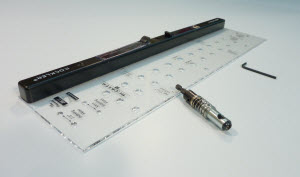 The Jig-It Shelving Jig, $35, from Rockler is purpose-built to address this specific requirement. It features a sturdy Plexiglas body with a series of laser-cut holes exactly 32 mm apart running on each side of the jig. There is also a handle that serves as an inset guide and attaches to one side for drilling holes 2-1/2" (64 mm) from the edge, or it can be switched to the other side for drilling holes 1-17/16" (37 mm) from the edge. The insets' positioning allows users to drill "Euro-style," whereas the Euro-style," if holes also carry the bracket of a European-style hinge and the screws for drawer slides.
The Jig-It Shelving Jig, $35, from Rockler is purpose-built to address this specific requirement. It features a sturdy Plexiglas body with a series of laser-cut holes exactly 32 mm apart running on each side of the jig. There is also a handle that serves as an inset guide and attaches to one side for drilling holes 2-1/2" (64 mm) from the edge, or it can be switched to the other side for drilling holes 1-17/16" (37 mm) from the edge. The insets' positioning allows users to drill "Euro-style," whereas the Euro-style," if holes also carry the bracket of a European-style hinge and the screws for drawer slides.
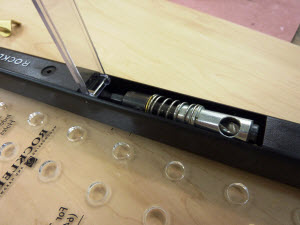 The jig also cleverly provides storage within the handle for all of the accessories that come with the jig, including the drill bit and hex wrench.
The jig also cleverly provides storage within the handle for all of the accessories that come with the jig, including the drill bit and hex wrench.
The jig accommodates two shelf pin sizes, 1/4" or 5 mm. When purchasing from Rockler, you can choose one of these drill bit sizes to be included as part of the bundle. For an additional $21.99, you can also buy the other size bit. If you prefer to use sleeved shelf pins, there are two drill bit sizes available for this application as well; 9/32" (1/4" pin sleeve) and 7/32" (5-mm pin sleeve).
 The operation of the jig is simple. Could you align the jig at the correct starting point for your application? The jig allows hole spacing in increments of 32 mm.
The operation of the jig is simple. Could you align the jig at the correct starting point for your application? The jig allows hole spacing in increments of 32 mm.
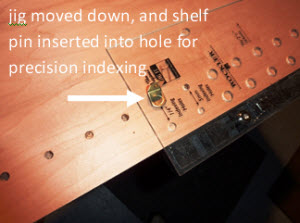 If the column of holes extends beyond the capacity of the jig (a common occurrence in large carcass construction), slide the jig to the next section and use a shelf pin to index the jig to the previously drilled holes. This allows the series of holes to continue without disruption to spacing.
If the column of holes extends beyond the capacity of the jig (a common occurrence in large carcass construction), slide the jig to the next section and use a shelf pin to index the jig to the previously drilled holes. This allows the series of holes to continue without disruption to spacing.
Strengths: This jig is solidly constructed, offering spot-on accuracy and repeatability. It also enables one to proceed through the task of drilling shelving holes quickly and without needing a tape measure, pencil, and square, which may be required for drilling accurate holes without this jig. I also set it up and used it within minutes without reading any instructions, which greatly validated its simple design. I recently used the jig to drill holes for three large bookcases, and I would estimate that I could drill all of the holes in roughly 1/3 the time it would take without the jig, without any misses, or worse, holes drilled through the sidewall of the bookcase. The solid construction also suggests that I am not likely to wear it out. George Vondriska, Managing Editor of WWGOA, has been using this jig in his cabinetmaking class (one jig shared by up to six students) for roughly five years, and he indicated that the jig still performs well and shows little sign of wear. The jig is also versatile enough for cabinets with a face frame or frameless construction with equal ease.
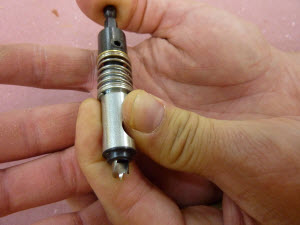 Another key strength of the jig's design is the self-centering drill bit. The bit is extremely well-made and requires no adjustments.
Another key strength of the jig's design is the self-centering drill bit. The bit is extremely well-made and requires no adjustments.
 A collar forces the bit to be perfectly centered in the jig hole, and a solid ridge above the collar ensures a positive stop at a depth of 9/16", which will not blow through a typical cabinet carcass. The penetration is controlled, and the bit is safely retracted, from the tension of an integrated spring.
A collar forces the bit to be perfectly centered in the jig hole, and a solid ridge above the collar ensures a positive stop at a depth of 9/16", which will not blow through a typical cabinet carcass. The penetration is controlled, and the bit is safely retracted, from the tension of an integrated spring.
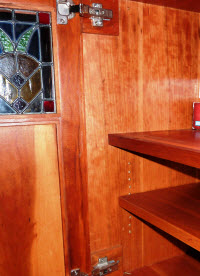 Drawbacks: While the design provides some flexibility in allowing holes to be drilled either 2-1/2" or 1-17/16" from the side, I occasionally build shelves which are set back from the edge a bit to create visual interest (see picture to the left). This would require an additional straight edge to be used as an auxiliary guide. Also, the only vertical spacing allowed for shelf pins is 32 mm. While this is typically workable, I am admittedly a bit of a "flexibility freak" and would prefer other spacing options. Although, it would only be possible to imagine gaining flexibility in this jig with compromising simplicity, one of its considerable strengths. So perhaps this suggestion falls into the "be careful what you ask for" category.
Drawbacks: While the design provides some flexibility in allowing holes to be drilled either 2-1/2" or 1-17/16" from the side, I occasionally build shelves which are set back from the edge a bit to create visual interest (see picture to the left). This would require an additional straight edge to be used as an auxiliary guide. Also, the only vertical spacing allowed for shelf pins is 32 mm. While this is typically workable, I am admittedly a bit of a "flexibility freak" and would prefer other spacing options. Although, it would only be possible to imagine gaining flexibility in this jig with compromising simplicity, one of its considerable strengths. So perhaps this suggestion falls into the "be careful what you ask for" category.
Recommendation: I considered buying one of these for years; each time, I painstakingly drilled shelf holes. It was one of those things that I could get by without, but once I picked one up, I wished I had done it years earlier. This jig is a no-brainer purchase if you build cabinets or furniture that utilizes shelving with any frequency. I consider it a reasonable value at $35, and I have seen it on sale for as low as $25.

I solved the tearout problem. I bought a corded Milwaukee 3/8" drill. It is much more powerful than any of my cordless drills. I noticed a couple of posts on the Rockler site that mentioned this as a possible fix for the tearout. I did order a new bit, but the old one works fine with the new drill.
Just found this post because I have had tearout issues in both Birch and Hickory veneer plywood since I started using the jig a month ago. Never occurred to me the bit might be defective. Thanks for the suggestion.
I was just out in the shop, and I used the jig/bit combo to drill holes in several different materials; pine, maple, birch, walnut, oak and cherry. I drilled into solid wood, plywood, and veneered MDF. I also tried varying the drill speed. In all of these variations, I was not able to produce any noteworthy tearout. Only a slight fuzzing of the hole's edge on a few of the holes, and this seemed to be a random occurrence. George asks a good question. Assuming the answer is yes, and if it has been producing tearout since day one as it sounds, I am suspicious that you received a bit that was defective.
Fred I've been using this jig in classes for many years. We build the cabinets out of oak faced veneer core plywood. I also use it in a class where we build the cases from melamine. I use the 5-mm bit and have never had a tearing issue in plywood or chipping issue in melmanine. Are you using Rockler's self-centering bit with your jig? G
Hi Fred, That is interesting. I have not found much tearout in using the jig so far. It will be interesting to see if anyone else chimes in with any experience here. I wonder if your bit was not honed properly in the manufacturing process. Or, perhaps you are using a more coarse-grained wood than I am (I have only used it on maple and birch so far), which may lead to a greater tendency to tear out. I will try some different tests to see if I find any conditions that lead to tearout problems. I wonder if it would help to dampen the wood slightly prior to drilling?
This is a terrific jig. I've owned one for over a year and actually used it yesterday in a shelf system I'm building for my shop. (aren't most of our projects for our shop?) The one BIG drawback is this: tearout in plywood. I've tried every drill I have, drilling slow, fast, whatever. I get tearout. I hope someone has some suggestions as how to avoid tearout with this bit.
Great to hear, Fred. Nice sleuthing!
Hi Fred, That is interesting. I have not found much tearout in using the jig so far. It will be interesting to see if anyone else chimes in with any experience here. I wonder if your bit was not honed properly in the manufacturing process. Or, perhaps you are using a more coarse-grained wood than I am (I have only used it on maple and birch so far), which may lead to a greater tendency to tear out. I will try some different tests to see if I find any conditions that lead to tearout problems. I wonder if it would help to dampen the wood slightly prior to drilling?
This is a terrific jig. I've owned one for over a year and actually used it yesterday in a shelf system I'm building for my shop. (aren't most of our projects for our shop?) The one BIG drawback is this: tearout in plywood. I've tried every drill I have, drilling slow, fast, whatever. I get tearout. I hope someone has some suggestions as how to avoid tearout with this bit.